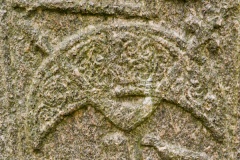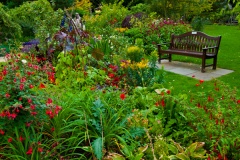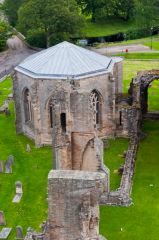
The Bishops of Moray couldn't seem to decide where to establish their cathedral. For many years the bishop's residence and cathedral rotated between the churches at Birnie, Kinneddar, and Spynie. In 1224 the cathedral was transferred to Elgin, in part to be closer to the burgeoning market there, and in part to be closer to the protection of the royal castle.
For the next 336 years, until the Reformation, Elgin Cathedral was one of the most important and impressive medieval buildings in Scotland, a testament to the power of the Bishops of Moray, who, incidentally, continued to live at Spynie, where the impressive remains of their palace can be seen today.

There was apparently a fire at Elgin in 1270 that necessitated a programme of rebuilding, but that was nothing compared to what was to occur a century later. The Earl of Buchan in 1390 was one Alexander Stewart, third son of Robert II, and a man known to history by the nickname 'The Wolf of Badenoch'.
Bishop Bur of Moray as at odds with Buchan, who presided over the north of Scotland like a modern gangster lord, demanding and receiving protection money. The Bishop, after many years of trouble with the Earl, had him excommunicated in 1390. Buchan retaliated by unleashing a ferocious attack on Moray. His men burned Elgin to the ground and sacked the cathedral.

knight n the nave
The cathedral was rebuilt, but it could not survive the ecclesiastical revolution of the 16th century, and after 1560 it was allowed to moulder into decay. Indeed, the lead was stripped from the cathedral roof and sold to meet the army payroll. In 1640 the local parish minister had the rood screen broken up and used for firewood!
In the south aisle is a memorial to the Anderson family of Linkwood, which at over 5 metres in height stands as the tallest gravestone in Scotland. In the nave is a huge statue of a bishop, crafted in larger than life perspective, along with a knight of similar size. These stone giants were originally carved to fit the central bell tower and be clearly seen at a distance, which explains their huge size.

Visiting Elgin Cathedral
There is a lot to see at Elgin, for despite the depredations of generations, much has remained. The chapter house must take pride of place; this delightful building is in excellent condition, with the roof supported on a beautifully slender central pillar.
Elgin's Pictish Stone
Just outside the chapter house is another of Elgin's treasures, a carved Pictish stone. One side of the stone is overtly Christian, with a carved cross, but the other side is covered with a hunting scene and deliciously pagan Pictish symbols including a crescent and z-rod. The stone was found at St Giles parish church in 1823 and moved to the cathedral grounds.



The imposing west front of the cathedral is still largely intact. You can climb the spiral stairs within the 4-storey towers and get wonderful views over the cathedral grounds from the roof. There are numerous tombs of bishops, including Bishop John of Winchester in the south choir chapel, with a beautifully carved effigy beneath a cusped canopy. In the same chapel are memorials to several Dukes of Gordon and their families. One of the finest is the tomb chest of Alexander Gordon, 1st Earl of Huntly (d. 1470).
Just outside the gates of the cathedral on King Street is a medieval building known as Bishop's House. It is almost certainly not a bishop's house, but is, in fact, the residence of a preceptor, or music master for the cathedral.


in the Bishop's House
The Biblical Garden
A few steps away is the most modern addition to the cathedral area, a wonderful walled garden known as The Biblical Garden. The garden is planted with plants mentioned in the Bible or known to have been in use at that time, interspersed with statues of people and events from the Bible. When I visited in late August the garden was an absolute riot of colour and was easily one of the most enjoyable gardens I had the pleasure of visiting in all of Grampian.


Elgin Cathedral is one of the finest medieval buildings in Scotland, and certainly one of the most memorable Scottish churches. It is a must-see.
IMAGES OF THE CHAPTER HOUSE



interior and column






 We've 'tagged' this attraction information to help you find related historic attractions and learn more about major time periods mentioned.
We've 'tagged' this attraction information to help you find related historic attractions and learn more about major time periods mentioned.


